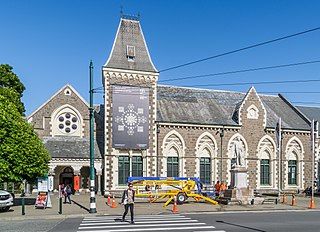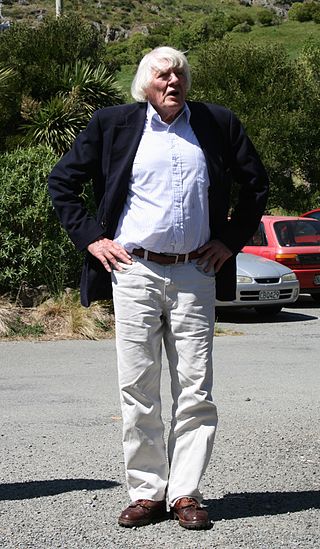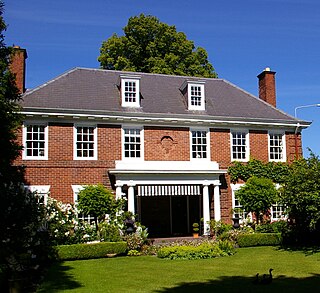
The University of Canterbury is a public research university based in Christchurch, New Zealand. It was founded in 1873 as Canterbury College, the first constituent college of the University of New Zealand. It is New Zealand's second-oldest university, after the University of Otago, which was founded four years earlier, in 1869.

Christchurch is the largest city in the South Island of New Zealand and the seat of the Canterbury Region. Christchurch lies on the South Island's east coast, just north of Banks Peninsula on Pegasus Bay. The Avon River (Ōtākaro) flows through the centre of the city, with an urban park along its banks.

TheArts Centre Te Matatiki Toi Ora is a hub for arts, culture, education, creativity and entrepreneurship in Christchurch, New Zealand. It is located in the Gothic Revival former Canterbury College, Christchurch Boys' High School and Christchurch Girls' High School buildings, many of which were designed by Benjamin Mountfort. The centre is a national landmark and taonga as it is home to New Zealand's largest collection of category one heritage buildings with 21 of the 23 buildings covered by Heritage New Zealand listings.

The Canterbury Museum is a museum located in the central city of Christchurch, New Zealand, in the city's Cultural Precinct. The museum was established in 1867 with Julius von Haast – whose collection formed its core – as its first director. The building is registered as a "Historic Place – Category I" by Heritage New Zealand.
Architecture of New Zealand is the built environment of regions, cities and towns of New Zealand.

The Christchurch Art Gallery Te Puna o Waiwhetū, commonly known as the Christchurch Art Gallery, is the public art gallery of the city of Christchurch, New Zealand. It has its own substantial art collection and also presents a programme of New Zealand and international exhibitions. It is funded by Christchurch City Council. The gallery opened on 10 May 2003, replacing the city's previous public art gallery, the Robert McDougall Art Gallery, which had opened in 1932.

William Alexander Sutton was a New Zealand portrait and landscape artist.

Christchurch Central City or Christchurch City Centre is the geographical centre and the heart of Christchurch, New Zealand. It is defined as the area within the Four Avenues and thus includes the densely built up central city, some less dense surrounding areas of residential, educational and industrial usage, and green space including Hagley Park, the Christchurch Botanic Gardens and the Barbadoes Street Cemetery.

The Canterbury Society of Arts Gallery, was an art gallery in the central city of Christchurch, New Zealand. It consisted of two buildings built in the late 1800s. The buildings were demolished in 2012 due to damage from the Canterbury earthquakes.
William Barnett Armson was an architect, surveyor, engineer in colonial New Zealand. A co-founder of the Canterbury Association of Architects, and an architect to the provincial government, he established the architectural firm of Armson, Collins and Harman in 1870, which remained active until 1993. It was one of the two oldest architectural firms in New Zealand. His most important work was the Bank of New Zealand building in Dunedin.

Peter Jamieson Beaven was a New Zealand architect based in Christchurch, who lived for his last few months in Blenheim. He was a co-founder of New Zealand's first heritage lobby group, the Civic Trust.

Douglas Kerr MacDiarmid was a New Zealand expatriate painter, known for his diversity and exceptional use of colour, and involved with key movements in twentieth-century art. He lived in Paris, France, for most of his career.
The Group was an informal but influential art association formed in Christchurch, New Zealand in 1927. Initially begun by ex-students from Canterbury College of Art, its aim was to provide a freer, more experimental alternative to the academic salon painting exhibitions of the Canterbury Society of Arts. The Group exhibited annually for 50 years, from 1927 to 1977, and it was continuously at the forefront of New Zealand art's avant-garde scene.

The Physics Room is a non-commercial contemporary art gallery in Christchurch, New Zealand, described as "one of the country's best-known contemporary experiential art spaces". It is primarily funded by Creative New Zealand, one of four contemporary art spaces thus funded since the mid-1990s. The Gallery is overseen by a charitable trust governed by a board of trustees.
Charles Eldon Fayne Robinson is a New Zealand Māori artist specialising in carving. Robinson has contributed to the carving of buildings on many marae in New Zealand as well as exhibiting his art in galleries and museums.

Weston House was a substantial two-storey heritage building in Christchurch, New Zealand, designed by architect Cecil Wood in Neo-Georgian style for George Weston, and completed in 1924. Registered as a Category I heritage building since 1983, it was demolished after the 2011 Christchurch earthquake.

Worcester Street is a road in the central city of Christchurch, New Zealand. It runs from the intersection of Rolleston Avenue in the west, and terminates in the east at the intersection of Woodham Road in Linwood. Between Rolleston Avenue and Cambridge Terrace, it is known as Worcester Boulevard.
SCAPE Public Art is a producer of public art in Christchurch, New Zealand. Deborah McCormick started SCAPE Public Art in 1998.
Nina Oberg Humphries is a New Zealand multimedia artist and Pacific arts advocate and multimedia artist of Cook Islands descent. Born in Christchurch in 1990, Oberg Humphries graduated from Ilam School of Fine Arts at the University of Canterbury in 2015.














